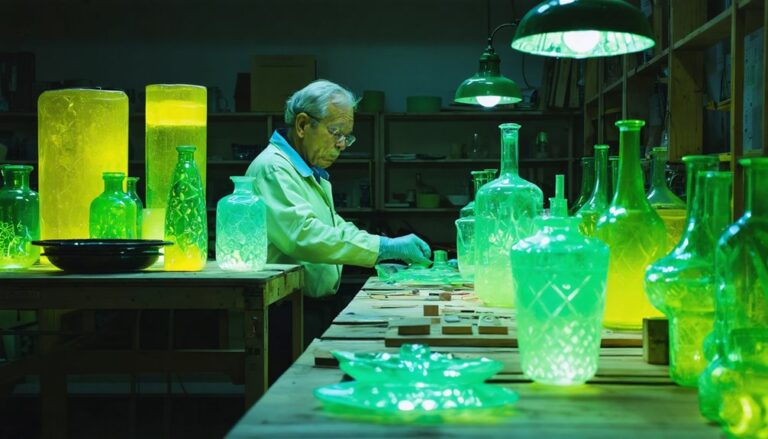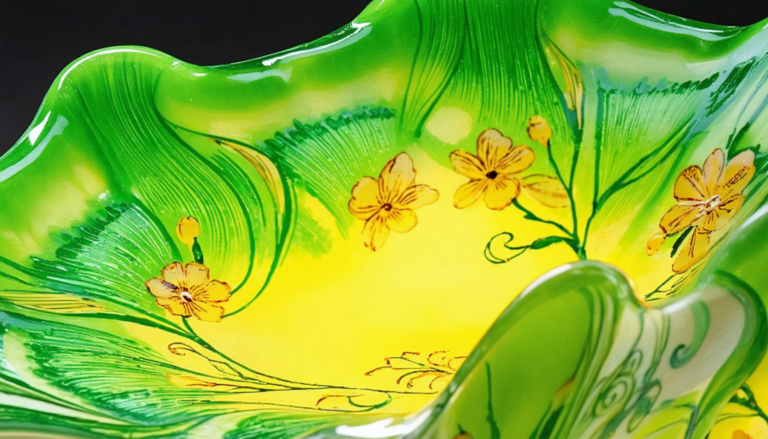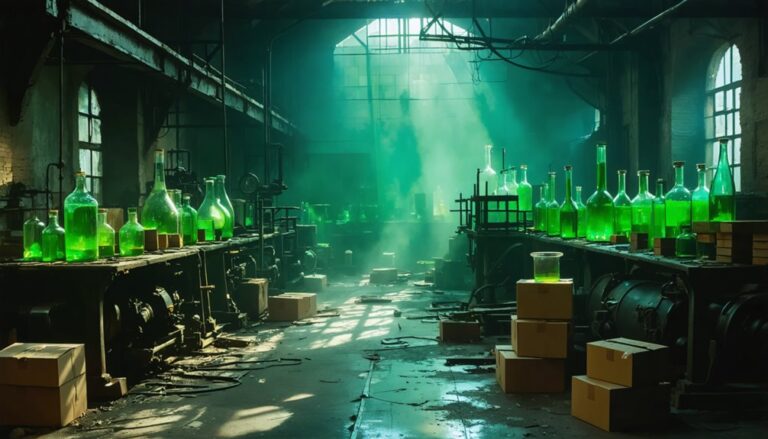Early American Uses of Uranium Glass
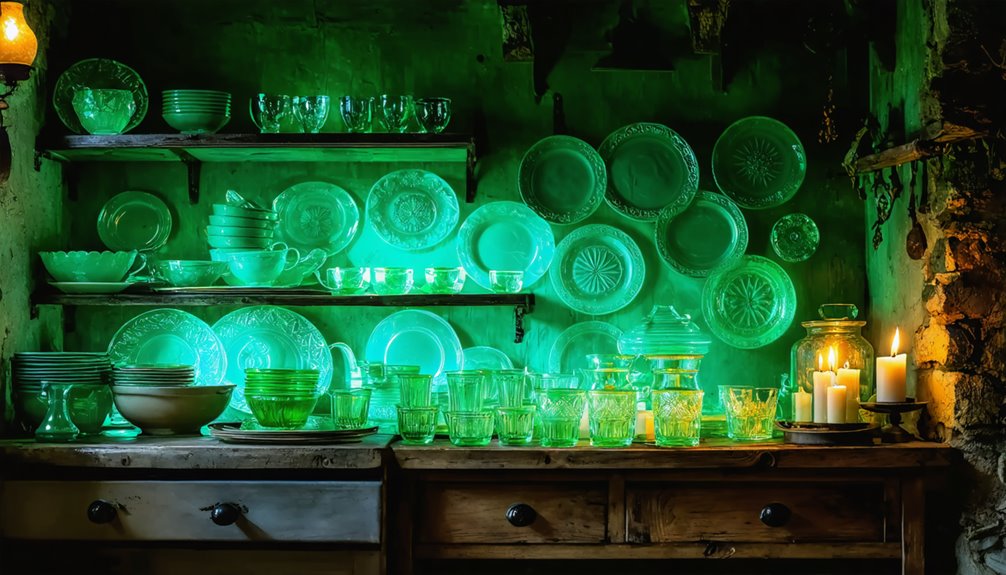
In the late 1800s, American craftsmen began to embrace uranium glass, inspired by designs from Europe. Companies like the Corning Company and talented innovators such as Frederick Carder at Steuben Glass Works crafted eye-catching yellow-green glassware. This remarkable vaseline glass shone brightly under ultraviolet light.
People used uranium glass in various household items, including tableware, decorative figurines, lamp bases, and stylish storage jars. Owning this unique glass was a symbol of wealth and sophistication. It showcased a person’s modern taste and appreciation for fine craftsmanship.
The history of uranium glass is not just about its appearance. It reflects a time when materials and design were evolving. The use of uranium in glassmaking also highlights the intersection of art and science during that era. Many collectors today seek out this distinctive glass, drawn by its beauty and rich history.
Key Takeaways
Uranium glass found its way into many early American homes. People used it for decorative tableware. Plates, bowls, cups, and serving pieces shone with a special glow.
Lighting fixtures also featured uranium glass. Lamp bases and candle holders became popular. The unique luminescence made them stand out in any room.
Affluent families sought out prestige items made from uranium glass. Ornate vases and decorative figurines represented their wealth and social status.
Manufacturers like Corning Company and Steuben Glass Works created innovative designs. Their work shaped early American tastes in decoration.
The use of uranium glass peaked during the Art Nouveau and Progressive eras. This period was marked by a love for bright and stylish domestic items. People embraced these vibrant pieces to enhance their homes.
Emergence of Uranium Glass in Early American Craftsmanship
Uranium glass started in Europe but found a warm welcome in America during the late 19th century. American craftsmen, inspired by innovative manufacturers like the Corning Company, began to explore its unique properties. They discovered that uranium could create striking yellow-green colors in glass items. This vibrant hue became a hallmark of their work.
As more artisans joined the movement, uranium glass quickly gained fame, reflecting the artistic spirit of the Art Nouveau period. From the 1880s to the 1920s, millions of beautiful pieces of uranium glass were made. Each item showcased the skill and creativity of American artisans.
However, this golden age came to an abrupt end. The government began to focus on the Manhattan Project, which meant fewer resources for uranium glass production. As a result, the once-thriving craft faced significant challenges. The decline marked a bittersweet chapter in the history of American glassmaking.
19th-Century Manufacturers and Innovators
Uranium glass once captivated American consumers. Several key companies played a role in its design and production. Fenton Art Glass was one of them. They saw the charm of uranium glass and began to experiment with new techniques and colors. Their work highlighted the glass’s unique fluorescent qualities.
Across the ocean, the Whitefriars Glass Company made a significant mark on the American market in the 1880s. They mass-marketed uranium glass decorative items, which inspired local glassmakers to explore this intriguing material.
Frederick Carder, founder of Steuben Glass Works, was another important figure. His artistic vision led to the creation of distinctive types of uranium glass, like Vaseline glass. This type has a captivating yellowish-green glow that many found enchanting.
In the late 19th and early 20th centuries, these innovative manufacturers turned uranium glass from a niche item into a fashionable household good. People across the nation began to treasure it.
The early uses of uranium glass showed how creativity and vision could transform simple materials into beloved objects.
Common Household Items Incorporating Uranium Glass
Uranium glass became popular in American homes, moving beyond just a novelty item. Its unique glow under ultraviolet light attracted many. In the Victorian era, bright yellow-green Vaseline glass was widely used in both decorative and everyday items. Companies like the Fenton Art Glass Company played a big role in making uranium glass common in households. Families enjoyed having these distinct and useful pieces on display.
| Common Uranium Glass Items | Typical Uses |
|---|---|
| Tableware | Plates, bowls, cups |
| Decorative Pieces | Figurines, vases, ornaments |
| Lighting Fixtures | Lamp bases, candle holders |
| Serving Items | Pitchers, creamers, sugar bowls |
| Storage Containers | Jars, canisters |
People found uranium glass appealing for its beauty and functionality. It added a touch of elegance to dining tables and living spaces. Items like plates and bowls became vibrant parts of family meals. Decorative pieces brightened up shelves and mantels. Lighting fixtures brought a warm glow to homes. Serving items were both practical and stylish, making gatherings more enjoyable. Storage containers offered a unique way to keep kitchens organized.
Uranium Glass as a Symbol of Prestige and Taste
In the late 19th and early 20th centuries, owning uranium glass was a sign of wealth and taste. This glass, known as Vaseline glass, was popular among affluent families. They showcased it proudly in their homes. The glass had a unique glow under UV light. This glow represented scientific progress and modernity.
The appealing designs and intricate patterns made uranium glass more than just ordinary tableware. People began to collect it. At social gatherings, showcasing this glass revealed one’s refined taste. It showed that they belonged to the upper class.
Uranium glass wasn’t just functional. It symbolized social status and cultural sophistication. People admired the elegant innovations of that time. The vibrant glow and distinctive beauty of Vaseline glass made it a sought-after item, reflecting the spirit of a forward-thinking society.
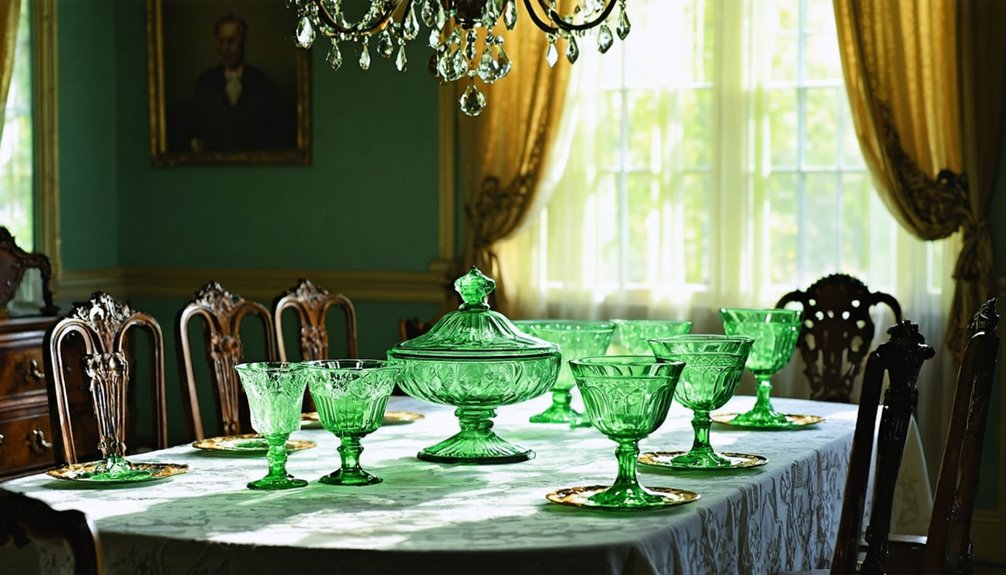
Popularity Patterns From the Victorian Era to Early 20TH Century
Uranium glass has a fascinating history, especially during the Victorian era. People in America became captivated by its bright yellow-green color. They were also intrigued by how it glowed under ultraviolet light. This glass wasn’t just beautiful; it was unique and drew attention.
As time went on into the Progressive Era, tastes began to change. People started to prefer household items that were both useful and stylish. Uranium glass fit right into this new trend. It symbolized modernity and scientific advancement. Many families began to see it as a must-have item for their homes.
Companies like the Whitefriars Glass Company played a big role in this. They produced a wide range of uranium glass products, from tableware to decorative lamps.
This glass quickly became a common sight in homes across America, reflecting the changing attitudes toward design and functionality. The appeal of uranium glass wasn’t just in its looks but also in what it represented—a leap into the future.
Victorian Era Fascination
During the Victorian era, uranium-infused glass, commonly known as “Vaseline glass,” enjoyed immense popularity. This glass, with its unique yellow-green glow, fascinated many. In the late 19th century, production of this radiant glass surged. Collectors and everyday households alike were drawn to its fluorescent charm.
Vaseline glass wasn’t just decorative; it served practical purposes too. People used it for various items in their homes. It created a sense of warmth and belonging. As scientific discoveries flourished, the Victorians embraced uranium glass, celebrating its vibrant glow.
Different types of uranium glass items appealed to various emotions. Elegant vases offered a sense of refinement and beauty. Ornate bowls brought warmth and comfort, helping to shape family identity. Unique jewelry pieces allowed for personal expression and a feeling of belonging among wearers.
The allure of uranium glass reflected a broader fascination with science and innovation during the Victorian era. This glass brought joy and a touch of magic to everyday life, making it a cherished part of the period’s cultural landscape.
Progressive Era Glass Trends
As America entered the Progressive Era, from the 1880s to the 1920s, uranium glass became increasingly popular. This rise was largely due to improvements in manufacturing techniques and effective marketing.
Factories could now produce uranium glass on a large scale, making it affordable for many families. People were drawn to its striking yellow-green color, especially when it glowed under ultraviolet light.
During this time, the Victorian interest in science played a big role. Many individuals wanted to own trendy and modern items for their homes. Companies like Fenton Art Glass capitalized on this trend by creating beautiful decorative pieces. They were instrumental in making uranium glass a household name.
However, the landscape changed drastically during World War II. The government recognized uranium’s strategic military value, leading to a significant decrease in its production for civilian use.
This shift marked the end of uranium glass’s golden age.

Collectors and Enthusiasts Preserving Early American Uranium Glass
Uranium glass has a rich history in America. It began in the early 19th century when glassmakers discovered that adding uranium to glass could create vibrant colors and improve clarity. This unique glass became popular for its striking appearance, often glowing under ultraviolet light.
One of the most well-known producers of uranium glass was the Fenton Art Glass Company. Their creations, along with those of other manufacturers, introduced various styles like Vaseline glass, custard glass, and jadite glass. Each type holds its own charm and story, capturing the interest of collectors and history buffs alike.
Groups such as Vaseline Glass Collectors, Inc. exist to foster connections among enthusiasts. They encourage sharing knowledge and experiences about this remarkable glass. Resources like the Uranium Glass Identification Guide assist collectors in identifying and preserving their treasures properly.
The value of uranium glass can vary significantly. Some everyday items can be found for less than $100. However, rare pieces can fetch prices exceeding $10,000.
Collectors recognize the importance of understanding this market and the historical context behind each piece they acquire. This shared passion for early uranium glass helps keep its legacy alive.
Frequently Asked Questions
How to Tell if Uranium Glass Is Vintage?
To identify vintage uranium glass, first look for any unique markings, like maker’s stamps. These stamps can tell you who made the glass and when. Knowing the history of uranium glass helps too.
Collectors have guides that list production dates. This can give you a timeline for when your piece was made. You might also notice different colors. Vintage uranium glass often shows a range of green to yellow hues. Thickness can vary, and older pieces may feel different in weight.
Surface textures are important as well. Early pieces might have a smoother feel, while later versions may show more patterns or designs. Understanding the style evolution gives context to your glass.
Finally, if you want to confirm authenticity, try the glow test. Uranium glass glows bright green under UV light. This is a fun way to see if your piece is the real deal.
What Was Uranium Glass Used For?
Did you know about the fascinating history of uranium glass? Today, around 4 million pieces exist. These items are not just pretty decorations. They have served various purposes throughout history.
Uranium glass, also known as Vaseline glass, has been used in scientific experiments. Scientists appreciated its unique properties. The glass glows under ultraviolet light because of the uranium content. This made it valuable for research purposes.
People also created beautiful jewelry from uranium glass. The vibrant green and yellow colors attracted many collectors. Antique shops often feature these eye-catching pieces.
In industrial settings, uranium glass was useful too. Manufacturers incorporated it into everyday items, like tableware. The glass was popular from the late 19th century to the mid-20th century.
As you can see, uranium glass has an intriguing past. It blends science, art, and industry into one fascinating material.
What Were Some of the First Uses of Uranium?
Uranium has had a fascinating history, especially in the realm of glassmaking. One of the earliest uses of uranium was in creating uranium glass, also known as Vaseline glass. This glass was made to have a unique greenish-yellow hue, which made it stand out in homes and collections.
The excitement around uranium glass started in the late 19th century. Manufacturers discovered that adding small amounts of uranium oxide to glass could enhance its color and give it a distinctive glow under ultraviolet light. This property made it popular for decorative items, such as vases and tableware.
People were drawn to the vibrant colors and the novelty of uranium glass. It became a fashionable choice for dinnerware and collectibles. However, there were health concerns associated with uranium. Over time, awareness of radiation risks grew, leading to changes in how it was used.
Despite these concerns, uranium glass remains significant in history. It reflects the blend of science, art, and industry during its time. Today, many collectors appreciate uranium glass for its unique aesthetic and historical importance, serving as a reminder of the past.
Is Vintage Uranium Glass Valuable?
Uranium glass, also known as Vaseline glass, has a fascinating history. It first appeared in the early 19th century, during the height of glass manufacturing in Europe. This unique glass contains small amounts of uranium, which gives it a distinctive greenish hue and makes it glow under ultraviolet light.
Initially, uranium was used for its color and the way it enhanced the glass’s appearance. Many glassmakers believed that it added beauty and vibrancy to their creations. In the late 1800s, the glass became popular in households, with items like dishes, bowls, and decorative pieces being produced in large quantities.
As time went on, the use of uranium glass declined. By the mid-20th century, concerns about radiation began to grow. Manufacturers stopped using uranium in glass production, making the remaining pieces more rare and sought after by collectors.
Today, vintage uranium glass is highly valued by collectors. The interest in its history, along with its unique properties, has created a thriving market. The value of these pieces often depends on their condition, rarity, and historical context. Collectors appreciate not just the beauty of the glass, but also the stories behind each piece.
Conclusion
Uranium glass, known for its vibrant glow, tells a unique story about early America. From beautiful goblets to simple lamps, this glass reflects a time when creativity thrived in American homes. It was popular in the late 19th and early 20th centuries. People loved its bright colors and the way it shimmered under light.
As the years passed, uranium glass fell out of style. By the early 1900s, its use declined. However, many collectors today cherish these pieces. They work hard to preserve this shining part of our history. Collectors see value in uranium glass, not just for its beauty but also for what it represents: American skill and innovation.
Understanding uranium glass goes beyond just spotting it in a collection. It opens a window into a fascinating chapter of American craftsmanship. Each piece carries a legacy filled with artistry. This glass reminds us of a time when everyday objects combined function with prestige. Even today, the allure of uranium glass continues to captivate those who appreciate its history and charm.
